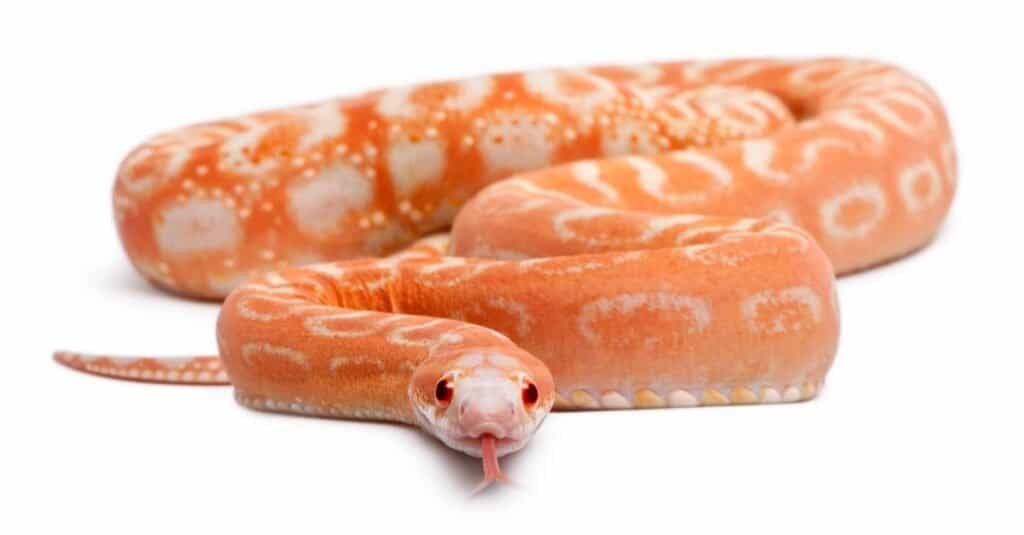
Snakes’ unique color patterns were developed as a mechanism to frighten off predators
©iStock.com/GlobalP
No matter how you feel about snakes, it’s hard to deny their captivating beauty. Considering that there are over 3,900 species of snakes spread throughout the world, it’s no wonder that they come in various sizes, colors, and patterns. Most of us are only familiar with the average garden snakes found in our backyards or the dreaded copperheads and cottonmouths. However, outside of being deadly and dangerous, we can also admire snakes for their beauty.
Snakeskin has cells called chromatophores that are limited to producing colors such as brown, black, and red. Iridophore cells produce iridescence, which is reflected by chromatophores in some snakes. How, then, are snakes other colors like purple, yellow, green, and blue? Well, the basic colors produced interact or are available in varying quantities or qualities, leading to the various colorations and patterns found in different species.
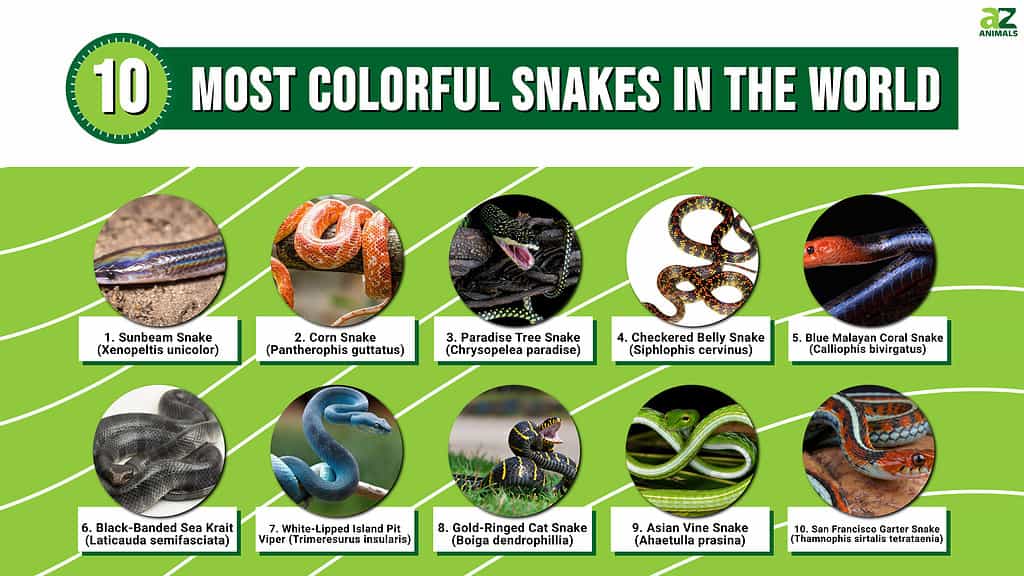
Snakes have developed different, unique colorations and patterns over time as a mechanism to hide from predators, lure in prey, or even scare off any threats. Depending on where they live, what they hunt, the climate, and other factors, snakes adapt to these and appear accordingly.
We’ve narrowed down our list to the ten most colorful snakes globally. Let’s explore what makes each of these animals so beautiful and unique.
10. San Francisco Garter Snake (Thamnophis sirtalis tetrataenia)
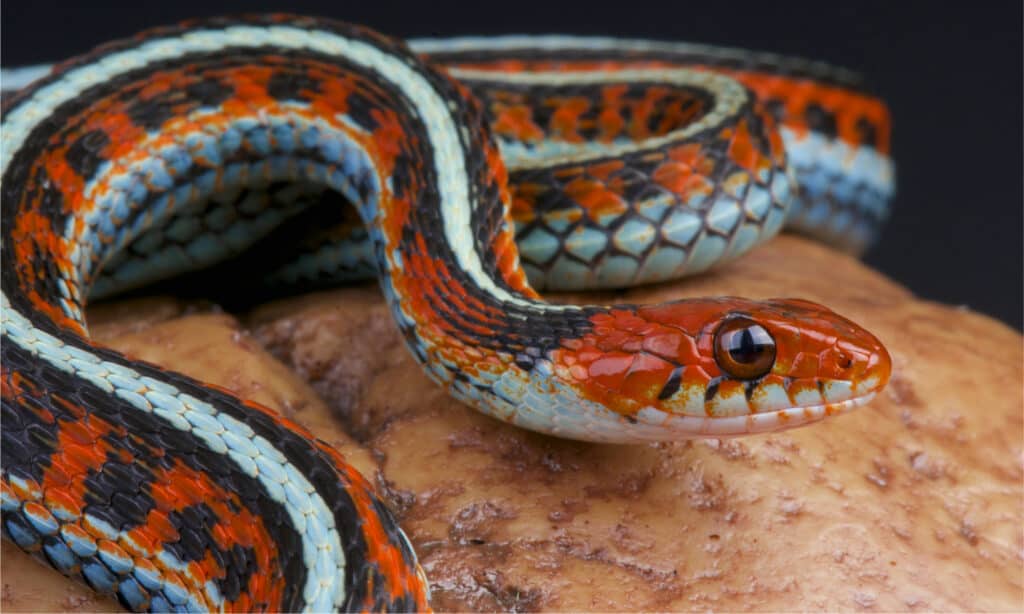
San Francisco garter snakes have blue-green spots at the front of their dorsal scales, surrounded by black, red, and blue-green stripes.
©reptiles4all/Shutterstock.com
Our list starts with the colorful snake known as the San Francisco garter snake. This snake is a small, multicolored subspecies of the ordinary garter snake. It is distinguished by a remarkable pattern of black, red, and blue-green stripes. After the Endangered Species Act was implemented, this snake was one of the first to be designated as endangered. It is a non-venomous snake that will capture and consume its victims whole.
San Francisco garter snakes are one of the few creatures that can consume the poisonous California newt. This species’ adult population is estimated to be between 1000 and 2000 snakes, according to researchers. They are really beautiful to look at and appear quite charming due to their many pretty colors. They are just mildly venomous, so they do not pose a serious threat to people.
9. Asian Vine Snake (Ahaetulla prasina)
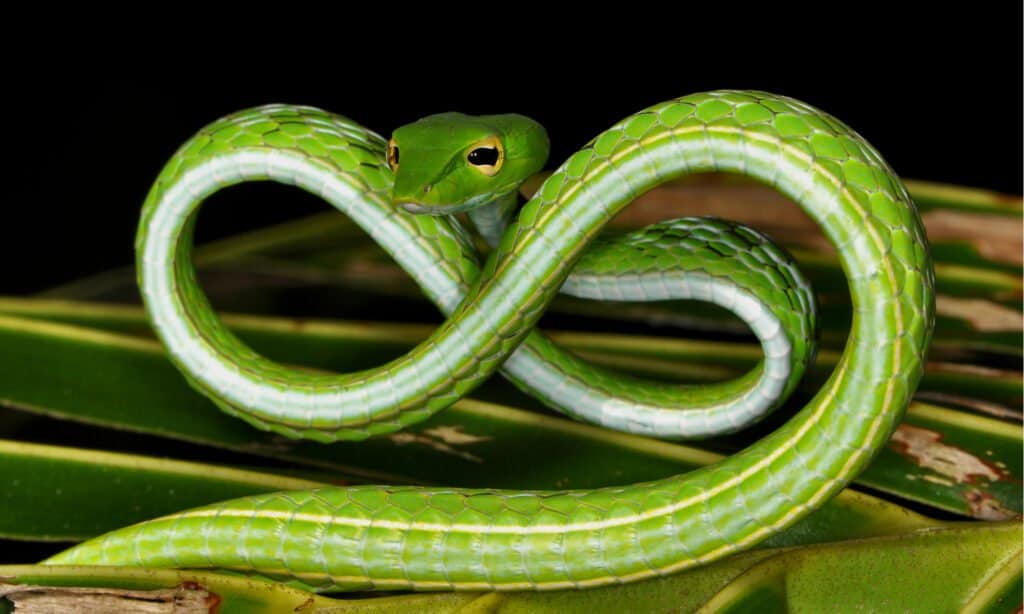
Green vine snakes are vivid green, which aids the population in creating effective concealment within trees.
©Ferdy Timmerman/Shutterstock.com
Ahaetulla prasina is a snake species native to southern Asia in the Colubridae family. It is also known as the Asian vine snake, Boie’s whip snake, Gunther’s whip snake, and Oriental whip snake. The body of this snake is a striking yellow-green color. It may stretch its body to expose a checkerboard pattern of bright and dark scales when necessary. The Asian vine snake has a thin body that becomes increasingly tapered towards the end. It might be all one color, have a broad yellow stripe down its body, or have darker green and blue streaks on its scales. Its primary colors range from vivid green to teal, which aids in concealment in the wild.
8. Gold-Ringed Cat Snake (Boiga dendrophillia)
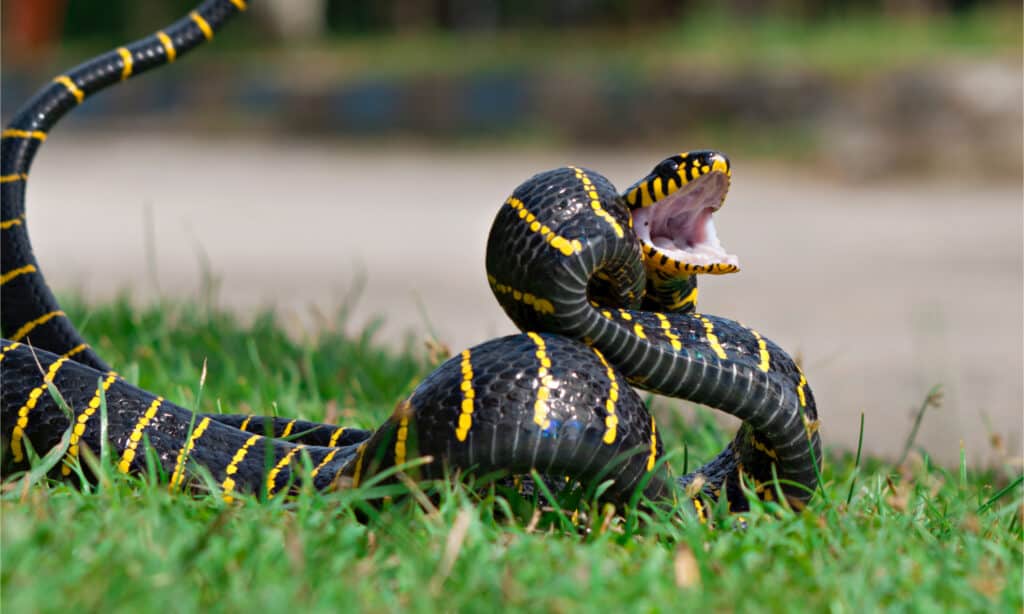
The mangrove snake has huge eyes with small, vertical slits, earning it the nickname “yellow-ringed cat snake.”
©Fernandha Theory/Shutterstock.com
The Mangrove snake, also known as the gold-ringed cat snake, is a subspecies of the Boiga dendrophila. At first glance, you might think that this snake looks exactly like a bumblebee. Colorful snakes like this one don’t come by often. The colors of this lovely snake will surely catch your eye, as its body is mostly black, but it is ringed with vivid yellow bands. Though not commonly kept in captivity, the gold-ringed cat snake is occasionally housed by expert snake keepers. It’s a venomous snake, but its venom isn’t potent enough to kill a person. These black and yellow mangrove snakes are found in many sections of South Asian forests.
7. White-Lipped Island Pit Viper (Trimeresurus insularis)
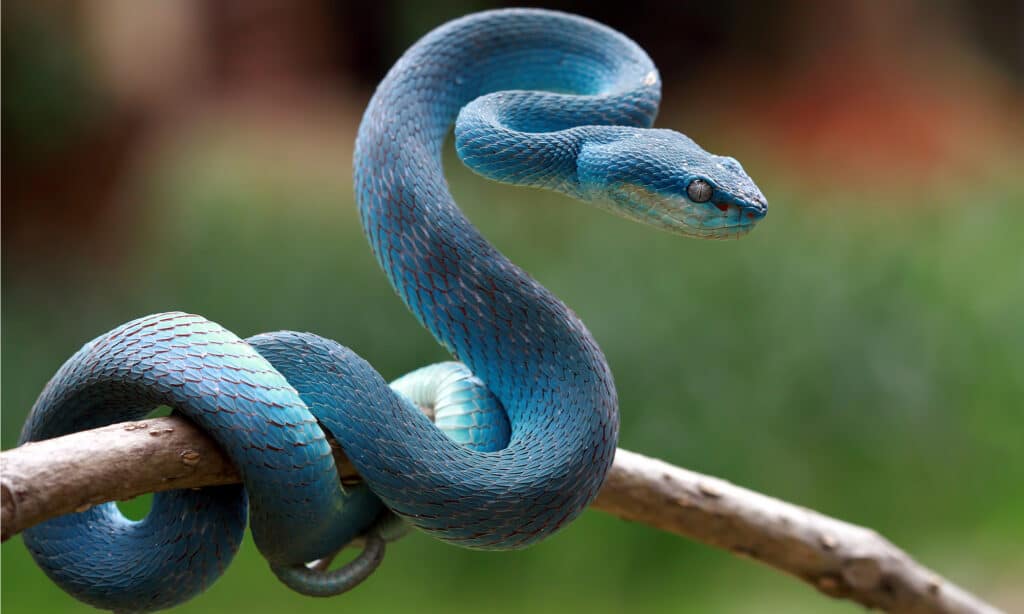
White-lipped pit vipers come in a variety of stunning hues.
©Kurit afshen/Shutterstock.com
Trimeresurus albolabris, often known as the white-lipped pit viper or white-lipped tree viper, is a venomous pit viper indigenous to Southeast Asia. This stunning viper is one of the world’s most attractive snakes. It comes in a variety of stunning hues. Some are turquoise, some are lime green, and others are yellow. White-lipped pit vipers are carnivorous and feed on prey in their immediate vicinity. Their natural habitat is in the woods, where they may be found in trees. They feed on amphibians, insects, and birds.
6. Black-Banded Sea Krait (Laticauda semifasciata)
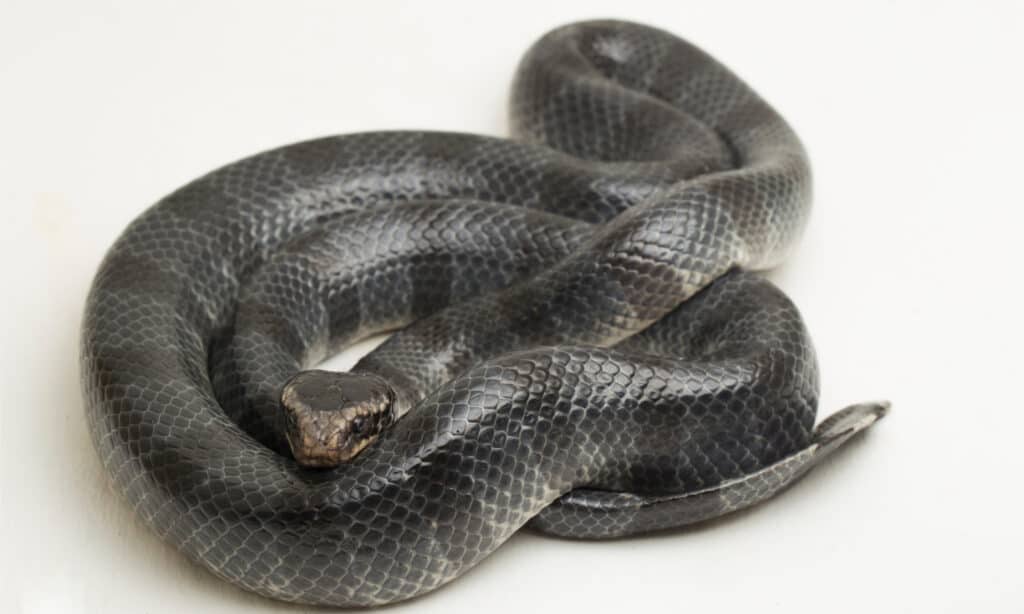
Black-banded sea
kraits
have black, vertical bars that stripe an otherwise white body, giving them their common name.
©dwi putra stock/Shutterstock.com
It is possible not only to find beautiful and colorful snake species on land but also in the sea. Banded sea kraits are also called yellow-lipped sea kraits because of the yellow upper lip above their black heads and the black stripes adorning their white bodies. These snakes act more like fish, hiding in coral reefs and waiting for prey. However, unlike fish, they breathe air and must surface every few hours to get air.
5. Blue Malayan Coral Snake (Calliophis bivirgatus)
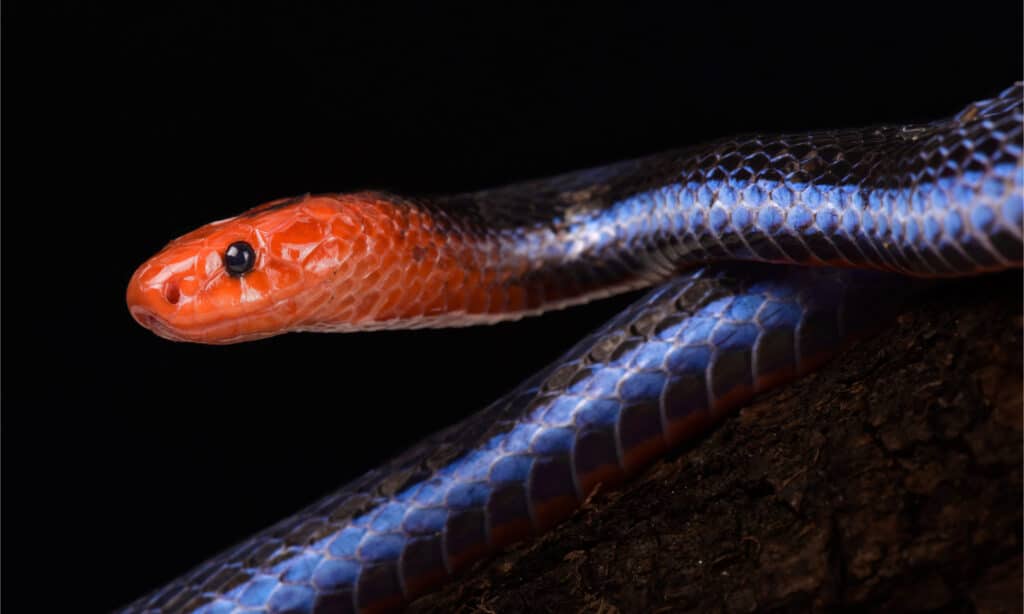
The blue Malayan coral snake is one of the biggest coral snake species.
©reptiles4all/Shutterstock.com
The blue Malayan coral snake is a colorful snake that dwells in Southeast Asia’s rainforests. It lacks bands, unlike its North American counterparts. It has a deep blue body with light blue or white stripes on each side, as well as a stunning coral-red head and tail. But don’t be misled by its beauty. It’s a venomous snake that has occasionally killed humans. However, its venom functions differently from that of most snakes. It inhibits sodium channels, resulting in near-instant paralysis.
4. Checkered Belly Snake (Siphlophis cervinus)
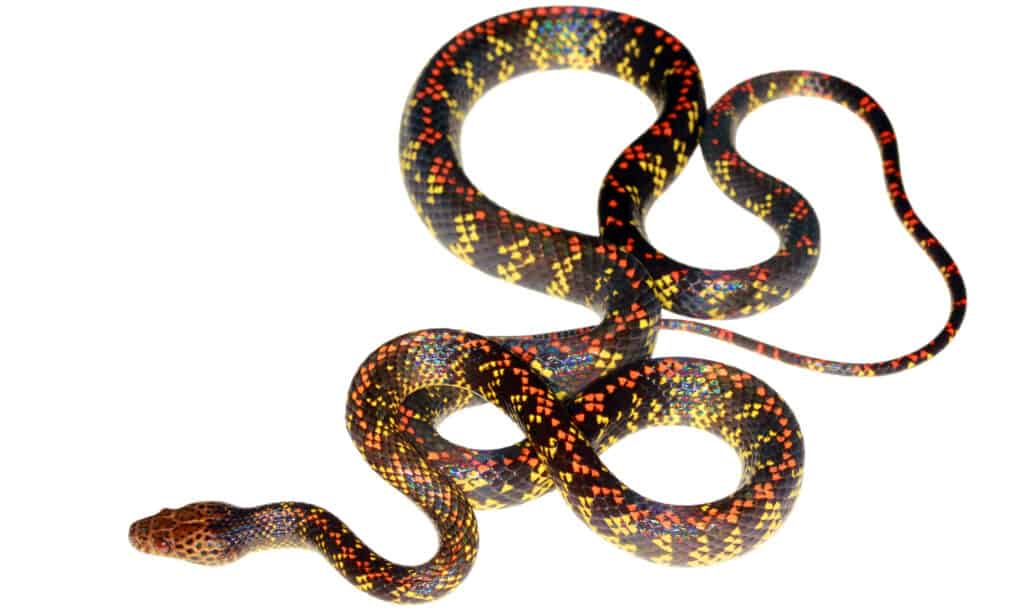
The checkered belly snake is one of the rarest in the world, as seeing them in person is almost impossible.
©Dr Morley Read/Shutterstock.com
The checkered belly snake is a rare species found in Amazonian South America as well as Trinidad and Tobago. Checker-bellied snakes are nocturnal species that are seldom seen during the day unless the conditions are similar to those of the night. Consider yourself extremely lucky if you see one since they are rare and hard to come by. The checker-bellied snake is long and skinny, with a broad head and bulging dark eyes. Its design is a checkerboard combination of orange, black, and brilliant yellow. This snake has a striking, detailed pattern that gives it the appearance of being beaded.
3. Paradise Tree Snake (Chrysopelea paradise)
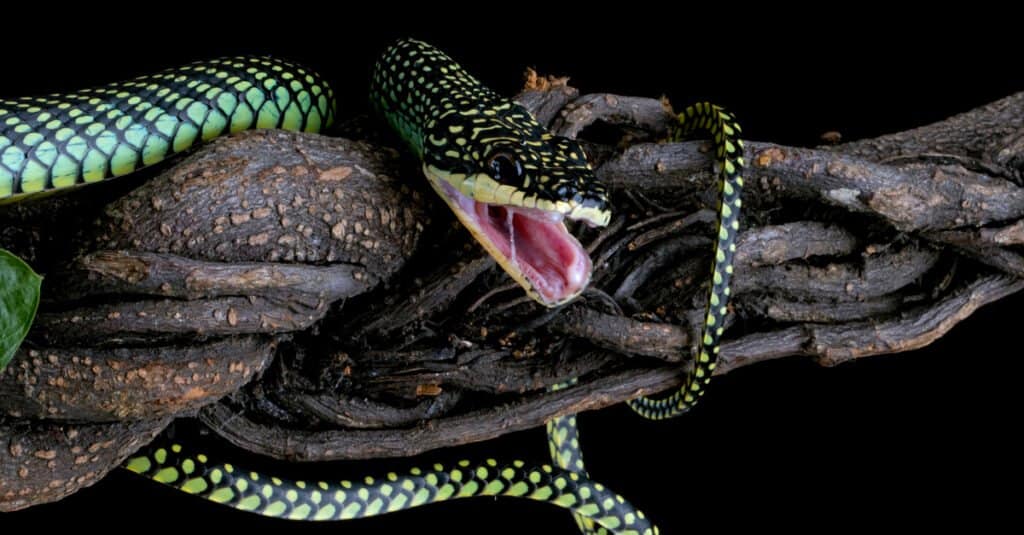
Flying snakes jump from tree to tree in order to prey and avoid predators.
©Kurit afshen/Shutterstock.com
The paradise tree snake, sometimes known as the paradise flying snake, is a kind of snake found in Southeast Asia. The basic color of this snake is black, and it appears to be covered with spherical dots. The color of the dots varies, but they are usually green, yellow, red, or a mix of the three. Outside of its gorgeous coloring, this snake also has a pretty impressive talent! It can flatten its body into a ribbon-like structure and fly into the air. The head stays relatively steady as the body moves. It can fly for 30 feet or more before landing when it begins to glide.
2. Corn Snake (Pantherophis guttatus)
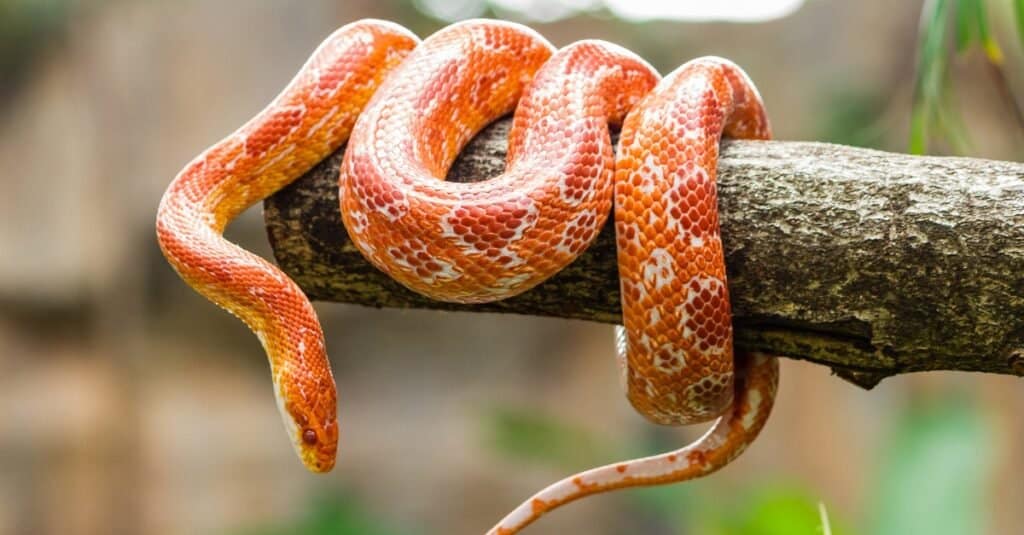
The corn snake is frequently misidentified as the deadly copperhead snake, causing many people to flee or kill it.
©iStock.com/bugphai
The corn snake is a kind of rat snake native to North America that uses constriction to subdue its victim. It may be found throughout the southeastern and central United States. Corn snakes have been deliberately bred to produce some very stunning color variations, making them particularly colorful snakes. Fluorescent hues, striped morphs, and even an “opal” kind that is white with streaks of pink or blue are among them. These docile snakes make wonderful pets. In fact, they are the world’s second most popular pet snake, trailing only the well-known ball python.
1. Sunbeam Snake (Xenopeltis unicolor)
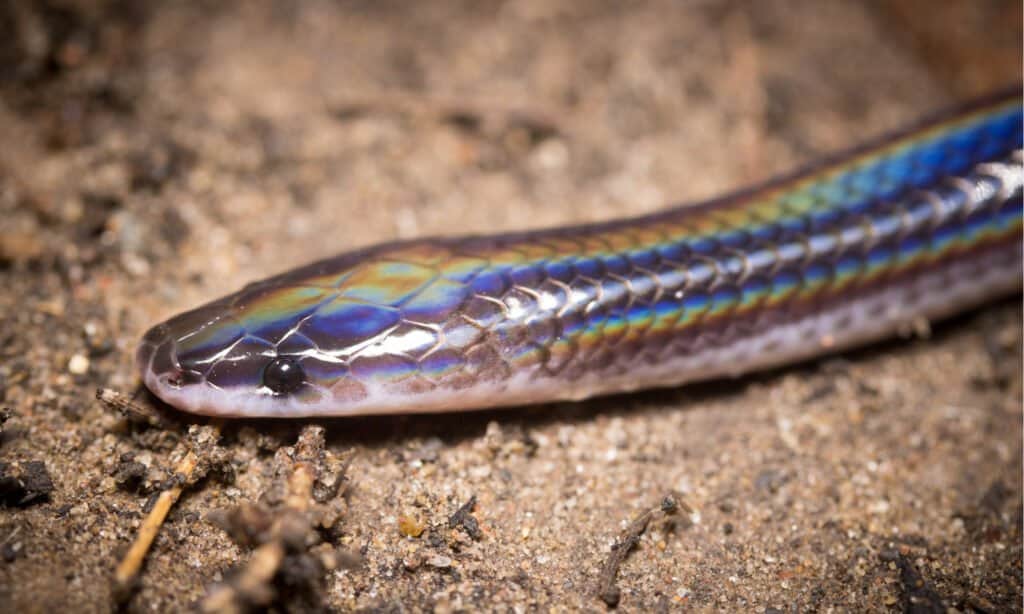
Sunbeam snakes have a layer of black pigmentation just beneath the surface of each scale, which adds to the iridescence.
©MP cz/Shutterstock.com
Would you believe us if we said you could see a rainbow in a snake? The sunbeam snake has iridescent scales that reflect practically every color in the rainbow. Underneath each scale is a coating of black pigment that enhances the shine. Sunbeam snakes are distinguished by their shiny, smooth, and iridescent scales. These snakes are non-venomous and use constriction to kill their prey. They typically avoid humans, but if they feel threatened, they will rattle the ends of their tails like rattlesnakes.
What Other Animals Are Especially Colorful?
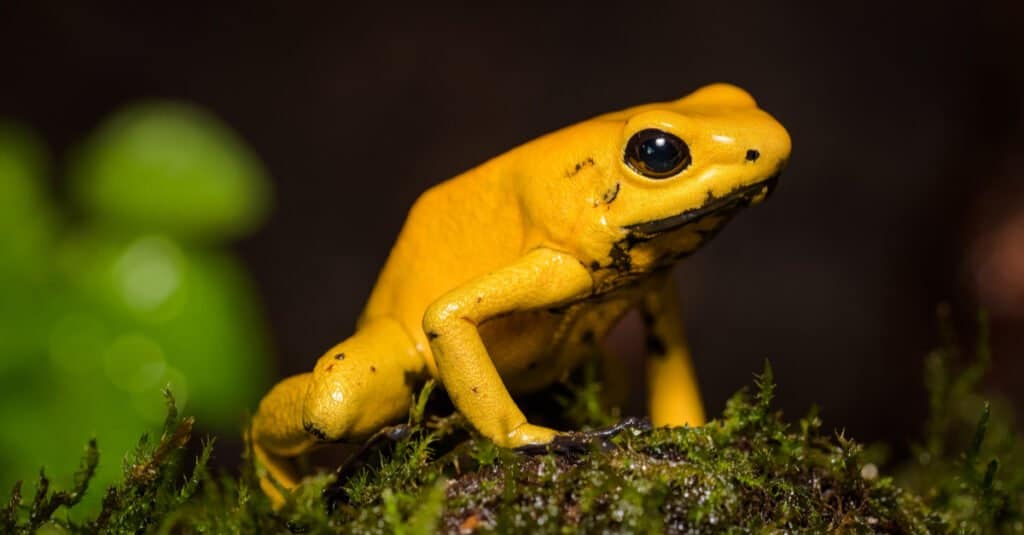
The Golden Poison Frog is the largest variety of the Golden Dart Frog and is especially venomous
©Thorsten Spoerlein/Shutterstock.com
Golden Dart Frog: The first thing you notice is the beautiful golden skin of this tiny frog with large dark eyes. That and the contrast between that gold and the speckled black of its limbs.
But before you give into the temptation to reach out to touch, a caveat: This amphibian is the most venomous creature on the globe and a single touch can prevent your heart from beating.
A particular species, the Golden Poison Frog, is actually the largest of all and may even be mint green or orange. It is also capable of affecting almost a dozen men. The strangest thing about this tiny frog is that it is free of toxins when raised in captivity, leading experts to believe that its potent venom is derived from its prey.
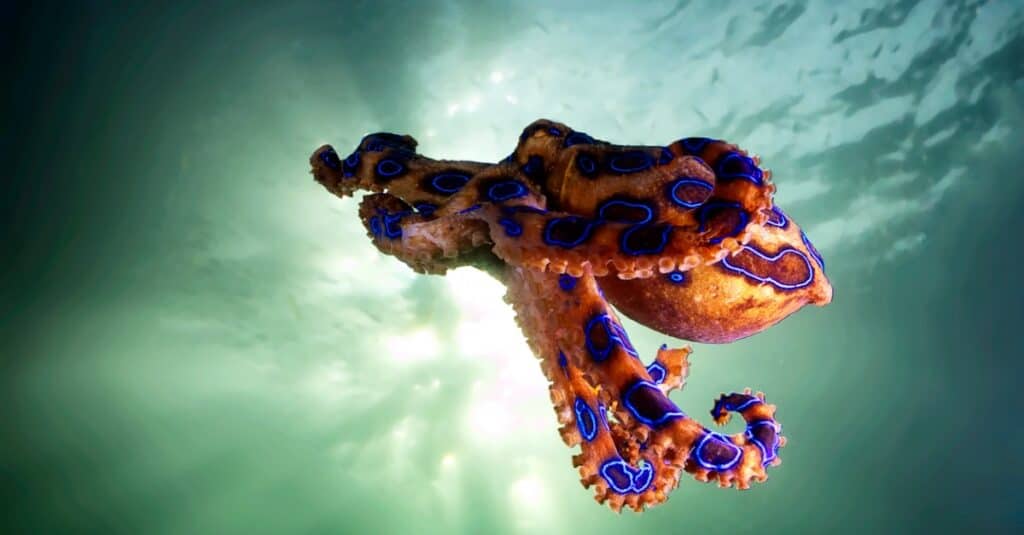
Blue-ringed octopuses are capable of releasing tetrodotoxin a neurotoxin that is 1,000 times more powerful than cyanide
©iStock.com/Subaqueosshutterbug
Blue-ringed octopuses: These nocturnal mollusks which love nothing more than feeding on small fish and crustaceans, are found in the tide pools, reefs, and algal beds of the Indian and Pacific Oceans. These cephalopods are known for the blue fluorescent rings which they flash when they feel threatened courtesy of special iridophores and chromatophores.
When threatened these octopuses release a potent neurotoxin, tetrodotoxin which paralyzes muscles, and is extremely dangerous as a result. The toxin itself has been described as being 1,000 times more powerful than cyanide.
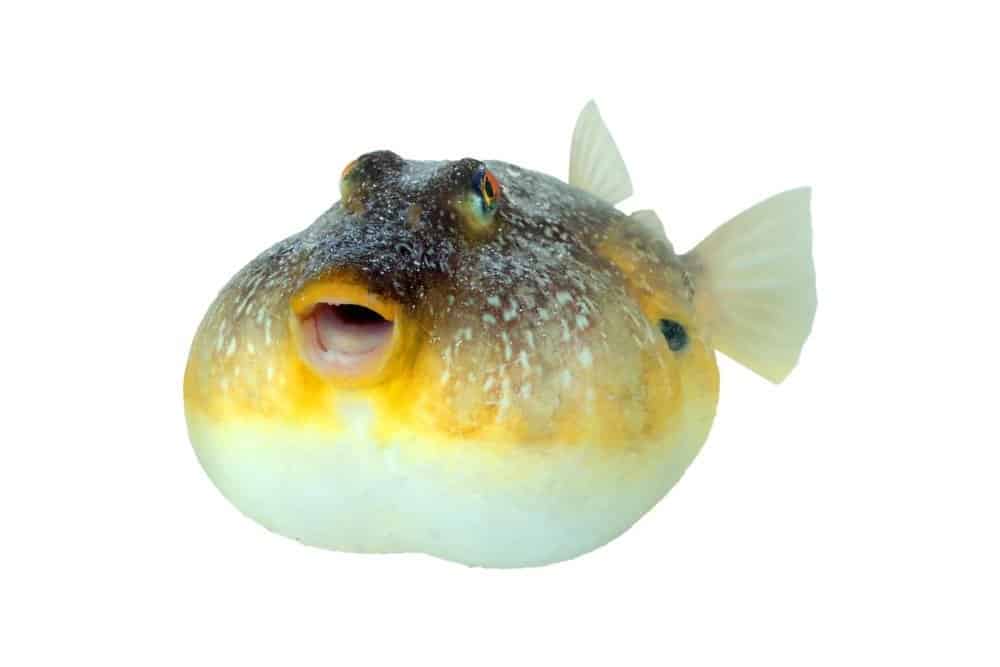
In spite of their extreme toxicity,
pufferfish
are also eaten in certain parts of the world
©IrinaK/Shutterstock.com
Pufferfish: This fish somewhat resembles an inflated balloon and looks deceptively harmless. As a matter of fact, it’s actually edible, but only if prepared with the utmost care, a process for which extensive training is required – and even then there are no guarantees.
Because this denizen of the seas comes with the same potent toxin as the blue-ringed octopus – tetrodotoxin. One fish is capable of posing a serious threat to about 30 people. The fish is known as fugu in Japanese and special chefs undergo about two or three years of training before being deemed worthy of serving one of the world’s most dangerous creatures on a plate.
Summary Of The 10 Most Colorful Snakes In The World
| Rank | Snake Species | Coloration |
|---|---|---|
| 1 | Sunbeam snake | Iridescent rainbow overlying black |
| 2 | Corn snake | Patterns of orange, white, sometimes blue, lavender |
| 3 | Paradise tree snake | Black with green “dots” Green belly Yellow spots on face; yellow mouth |
| 4 | Checkered belly snake | Orange, black, and yellow checkerboard pattern dorsal, lateral, ventral |
| 5 | Blue Malayan coral snake | Iridescent blue body with light blue lateral stripes Orange head |
| 6 | Black-Banded sea krait | Grey body with black bands |
| 7 | White-Lipped Island pit viper | Turquoise, green, or yellow |
| 8 | Gold-Ringed cat snake | Black body with yellow bands |
| 9 | Asian Vine snake | Lime green body, white belly Light/dark checkered scales scattered |
| 10 | San Francisco Garter snake | Light blue dorsal &, black stripes on either side Orange & black checkered sides Turquoise lateral band |
The photo featured at the top of this post is ©
Discover the "Monster" Snake 5X Bigger than an Anaconda
Every day A-Z Animals sends out some of the most incredible facts in the world from our free newsletter. Want to discover the 10 most beautiful snakes in the world, a "snake island" where you're never more than 3 feet from danger, or a "monster" snake 5X larger than an anaconda? Then sign up right now and you'll start receiving our daily newsletter absolutely free.
Thank you for reading! Have some feedback for us? Contact the AZ Animals editorial team.






